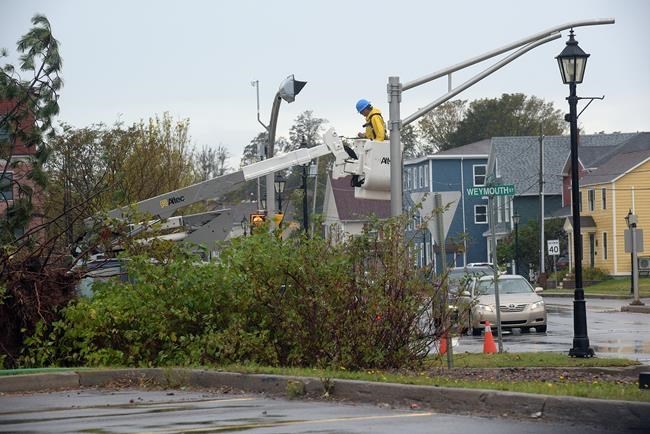CHARLOTTETOWN — The chief executive of Prince Edward Island's main electric utility says the firm is exploring ways to encourage the burying of distribution lines as it reflects on the massive damage of post-tropical storm Fiona.
Jason Roberts was testifying Monday before a legislature committee examining the impact of the storm and ways for Maritime Electric to improve the reliability of the grid.
"We have to recognize that there is a cost to the Prince Edward Island economy to be without power for three weeks," Roberts said.
"We need to start to think about what it means to the Island as a whole, and to have that conversation with our regulator and our customers, and to say maybe there are ways we could start to look at putting those lines underground."
The executive added that burying distribution lines — which are lower voltage than the main transmission lines — is four to five times pricier than keeping them overhead but is increasingly attractive as climate change makes high-intensity storms more likely.
Downed trees during Fiona have been acknowledged to be the primary source of widespread power outages in the province, which took 19 days to fully restore.
Figures presented on Monday indicated 35,000 trees had to be removed after Fiona, and repair crews had to fix 1,133 broken poles, 445 damaged transformers and 140 kilometres of downed wires.
Roberts and two other senior managers emphasized the major way to protect the grid against future severe storms would be cutting down and trimming more trees.
The subsidiary of Fortis Inc. is asking the Island Regulatory and Appeals Commission to allow increases in tree-cutting budgets from current levels of $3 million to about $5 million to $6 million.
However, members of the official Opposition Green Party noted evidence provided to the regulator shows Maritime Electric has fallen significantly behind neighbouring utilities in spending per kilometre on tree trimming, and they raised questions about why action wasn't taken sooner.
Hannah Bell, a Green Party member of the legislature, commented that she’s tiring of comments about how Fiona was a historic and unexpected storm, given the long-standing warnings that warmer North Atlantic waters would lead to higher-intensity storms.
"I don’t want to hear ‘unprecedented’ ever again, because we’re way past the point that we’re shocked by this now," she said.
Bell also asked the Maritime Electric executives whether any legislative changes were needed to speed adaptation to climate change, such as rules to encourage developers and new homeowners to put in underground lines.
In his response, Roberts shied away from suggesting steps the provincial government should take, saying that was up to the political leaders. He said the way forward may be to encourage individual property owners to consider burying lines by making it more attractive financially.
The executive noted that under existing rules, the power company pays for up to 90 metres of overhead lines from a road to a residential building, while homeowners pay the full cost of running a buried line to their homes.
"What we're thinking about in terms of the economics is that service line from the road to the homes is the first place we would look at for underground installation," he said.
"Maybe there should be a contribution from us (to install lines underground) ... that's the idea we're bouncing around," said Roberts.
However, when pressed by Green Leader Peter Bevan-Baker, Roberts said the utility does not have a target for burying a percentage of its lines each year. "It's something we would have to look into further and study and be comfortable with before we could take it to the regulator," he said.
This report by The Canadian Press was first published Oct. 31, 2022.
— By Michael Tutton in Halifax
The Canadian Press




